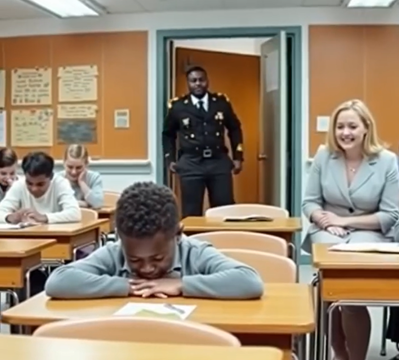On an otherwise ordinary Friday morning in Nashville, what began as a routine traffic stop quickly escalated into a confrontation that left one police officer seriously wounded and a woman dead. The incident, which unfolded within minutes, stunned the community and raised urgent questions about how quickly routine encounters can turn into matters of life and death. For many, the scene seemed more like something out of a crime drama than the daily work of local law enforcement.

The stop involved a black Chevrolet Camaro registered to 42-year-old Demond Buchanan, a convicted felon with six outstanding warrants for drug-related offenses. When Officer Josh Baker of the Metro Nashville Police Department pulled the car over around 9:30 a.m., he was on alert for the possibility that Buchanan himself might be inside. Instead, behind the wheel sat 31-year-old Nika Holbert. While her connection to Buchanan was not immediately clear, the interaction between Holbert and Baker soon became the focus of one of the city’s most widely discussed tragedies in recent memory.
At first, the conversation between officer and driver appeared relatively calm. Body-worn and dashboard camera footage, later released to the public, showed Baker asking Holbert questions before conducting a search of her belongings. In her purse, he discovered a small bag containing a suspicious powder, prompting him to move toward placing her under arrest. That discovery marked the turning point. Holbert grew visibly upset, insisting repeatedly that she had “done nothing wrong.” The tension in her voice, captured clearly on video, foreshadowed the escalation to come.
Metro Police Chief John Drake explained that the immediate release of the footage was intended to ensure transparency and public trust in such a sensitive matter. The videos revealed how swiftly the encounter unraveled. Holbert resisted Baker’s attempts to arrest her and eventually slipped back into the driver’s seat of the Camaro. Baker, determined to prevent her from fleeing, deployed his Taser. The device, however, did not subdue her. In the chaos that followed, Holbert produced a handgun. The footage captured Baker urgently pleading, “Ma’am, put the gun down!” But the warning came too late.
Holbert fired, striking Baker below his protective vest. The wound was severe, and for a moment it seemed the situation could claim the officer’s life. Despite his injury, the 14-year veteran of the force returned fire in self-defense. Holbert sped away in the Camaro, discarding her weapon along the way, but she crashed the vehicle only a short distance from the stop. Emergency responders rushed her to Skyline Medical Center, where she was later pronounced dead from her injuries.
Though gravely injured, Officer Baker managed to radio for assistance, reporting “shots fired” and alerting dispatchers that he had been struck. He was transported to Vanderbilt University Medical Center, where surgeons performed emergency treatment. Officials later confirmed that he was stable and expected to make a recovery, though his ordeal served as a stark reminder of the dangers law enforcement officers face daily.
The Tennessee Bureau of Investigation took over the case, with the goal of presenting findings to the District Attorney upon completion of the review. The investigation is expected to address not only the sequence of events but also the broader implications for police practices during traffic stops involving high-risk vehicles or individuals.
Chief John Drake emphasized that Officer Baker had attempted multiple non-lethal approaches before resorting to his firearm. Verbal commands, clear warnings, and the use of a Taser were all documented in the footage, underscoring his efforts to de-escalate. Drake defended Baker’s actions as a necessary response to an immediate life-threatening situation.
Holbert’s family, meanwhile, struggled with conflicting emotions in the aftermath. Her adoptive mother, Lisa Holbert-Gooch, publicly acknowledged the tragedy and expressed sorrow for both her daughter’s death and the officer’s injuries. She admitted that her daughter’s decision to fire at a police officer was wrong, yet she also expressed unease about how quickly the situation turned fatal. Her words reflected the complicated grief of a family caught between understanding accountability and mourning a devastating loss.
For Nashville residents, the event was deeply unsettling. It highlighted the unpredictable nature of police work and the fragile line between routine and catastrophe. Community members who viewed the footage were left grappling with questions about what drives such moments of desperation, how officers can best manage high-risk encounters, and what might prevent similar tragedies in the future.
The case also touched on broader national conversations about law enforcement transparency, accountability, and public safety. The release of the body camera footage allowed citizens to see the sequence for themselves, fostering dialogue but also raising uncomfortable questions about split-second decision-making under stress. For some, the video affirmed the risks officers face and the difficult choices they must make. For others, it underscored the need to understand the social and personal pressures that can lead individuals like Holbert to such desperate actions.
As the investigation continues, the city of Nashville is left to reflect on the lessons from this tragedy. For law enforcement, it is a reminder of the constant danger inherent in what might appear to be routine tasks. For the community, it is a call to acknowledge the human cost of these encounters—not just in terms of lives lost but in the ripple effects of grief, mistrust, and lingering questions.
Officer Baker’s recovery offers hope that at least one life will continue, but the scars—both physical and emotional—remain. Holbert’s death, meanwhile, leaves her family mourning and searching for answers. Together, their stories converge into a larger narrative about the delicate balance between enforcement and escalation, about how quickly fear can turn into violence, and about the lasting consequences of choices made in mere seconds.
Ultimately, the Nashville traffic stop serves as a sobering illustration of how fragile that balance is. It reminds us that behind every badge and every name is a human being—imperfect, vulnerable, and faced with decisions that can alter lives forever. And it reinforces that while transparency can provide clarity, it cannot undo the heartbreak left behind when routine encounters turn fatal.





